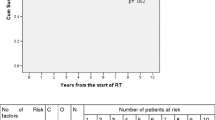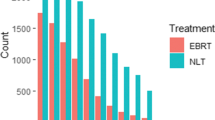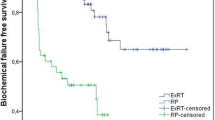Purpose:
To establish an initial database of external-beam radiotherapy (EBRT) for clinically localized prostate cancer used in Osaka, Japan, and, by analyzing the results of the Osaka multicenter cooperative study, to determine time trends, outcome, and applicability of existing and the authors’ original risk stratification methods.
Patients and Methods:
Data of 652 patients with clinically localized prostate cancer (T1–4 N0 M0) were accrued from July to December 2007. These patients had been treated from 1995 through 2006 with consecutive definitive EBRT of ≥ 60 Gy at eleven institutions, mainly in Osaka. Altogether, 436 patients were eligible for analysis using several risk stratification methods, namely, those of D’Amico et al., the National Comprehensive Cancer Network (NCCN), and Seattle, as well as the authors’ original Prostate Cancer Risk Index (PRIX).
Results:
The number of patients showed a tenfold increase over 10 years, together with a rapid spread of the use of Gleason Score from 0% to > 90% of cases. The dominant RT dose fractionation was 70 Gy/35 fractions (87%). Hormone therapy had been administered to 95% of the patients and the higher PRIX corresponded to the higher rate of hormone usage. 3- and 5-year biochemical relapse-free survival (bRFS) rates were 85% and 70%, respectively. The D’Amico (p = 0.132), NCCN (p = 0.138), Seattle (p = 0.041) and PRIX (p = 0.044) classifications showed weak or no correlation with bRFS, while the own modified three-class PRIX (PRIX 0, 1–5, 6) showed a strong correlation (p = 0.002).
Conclusion:
The use of prostate EBRT in Japan is still in its infancy, but is rapidly expanding. The short-term outcomes have been satisfactory considering the moderate RT dose. A very high rate of hormone usage may affect the outcome favorably, but also may compromise the usefulness of current risk stratification.
Ziel:
Erstellung einer ersten Datenbank zur perkutanen Strahlentherapie (EBRT) bei klinisch lokalisiertem Prostatakrebs in Osaka, Japan, und Ermittlung der zeitlichen Entwicklung, Resultate und Anwendbarkeit der existierenden und der eigenen Risikostratifikationsmethoden mittels Analyse der Ergebnisse der multizentrischen kooperativen Osaka-Studie.
Patienten und Methodik:
Daten von 652 Patienten mit klinisch lokalisiertem Prostatakrebs (T1–4 N0 M0) wurden von Juli bis Dezember 2007 erfasst. Diese Patienten waren zwischen 1995 und 2006 in elf Einrichtungen, vorwiegend in Osaka, mit konsekutiver definitiver EBRT von ≥ 60 Gy behandelt worden. Insgesamt 436 Patienten qualifizierten sich für die Analyse mittels mehrerer Risikostratifikationsmethoden, namentlich jener von D’Amico et al., National Comprehensive Cancer Network (NCCN) und Seattle sowie des eigenen Prostatakrebsrisikoindex (PRIX).
Ergebnisse:
Die Anzahl der Patienten stieg binnen 10 Jahren um das Zehnfache, und gleichzeitig kam es zu einem rasch zunehmenden Einsatz des Gleason-Scores von 0% auf > 90% der Fälle. Die dominante RT-Dosisfraktionierung betrug 70 Gy/35 Frak tionen (87%). Eine Hormontherapie war 95% der Patienten verabreicht worden, und der höhere PRIX entsprach der höheren Rate des Hormoneinsatzes. Die 3- und 5-Jahres-Raten des biochemisch rezidivfreien Überlebens (bRFS) lagen bei 85% bzw. 70%. Die Klassifikationen von D’Amico et al. (p = 0,132), NCCN (p = 0,138), Seattle (p = 0,041) und PRIX (p = 0,044) zeigten eine schwache Korrelation mit dem bRFS, wogegen der eigene modifizierte Drei-Klassen-PRIX (PRIX 0, 1–5, 6) eine starke Korrrelation (p = 0,002) ergab.
Schlussfolgerung:
Der Einsatz der Prostata-EBRT in Japan ist noch in der Anfangsphase begriffen, breitet sich aber rasch aus. Angesichts moderater RT-Dosen sind zufriedenstellende kurzfristige Resultate erzielt worden. Eine sehr hohe Rate von Hormonverabreichungen mag die Ergebnisse günstig beeinflussen, könnte aber auch die Nützlichkeit der gegenwärtigen Risikostratifikation gefährden.
Similar content being viewed by others
References
American Society for Therapeutic Radiology and Oncology Consensus Panel. Consensus statement: guidelines for PSA following radiation therapy. Int J Radiat Oncol Biol Phys 1997;37:1035–41.
Arai Y, Egawa S, Tobisu K, et al. Radical retropubic prostatectomy: time trends, morbidity and mortality in Japan. BJU Int 2000;85:287–94.
Cavey ML, Bayouth JE, Colman M, et al. IMRT to escalate the dose to the prostate while treating the pelvic nodes. Strahlenther Onkol 2005;181:431–41.
Center for Cancer Control and Information Services, National Cancer Center, Japan. Trend in age-standardized cancer mortality rate (world pop, major sites) [male 1958–2005]. Tokyo, Japan: National Cancer Center, 2006 (http://www.ganjoho.ncc.go.jp/professional/statistics/index.html).
Center for Cancer Control and Information Services, National Cancer Center, Japan. Trend in age-standardized cancer incidence rate (world pop, major sites) [male 1975–2001]. Tokyo, Japan: National Cancer Center, 2006 (http://www.ganjoho.ncc.go.jp/professional/statistics/index.html).
D’Amico AV, Whittington R, Malkowicz SB, et al. Biochemical outcome after radical prostatectomy, external beam radiation therapy, or interstitial radiation therapy for clinically localized prostate cancer. JAMA 1998;280:969–74.
Goldner G, Wachter S, Wachter-Gerstner N, et al. Long-term results in three-dimensional conformal radiotherapy of localized prostate cancer at moderate dose (66 Gy). Strahlenther Onkol 2006;182:537–42.
Guckenberger M, Flentje M. Intensity-modulated radiotherapy (IMRT) of ocalized prostate cancer. A review and future perspectives. Strahlenther Onkol 2007;183:57–62.
Ishikawa H, Tsuji H, Kamada T, et al. Carbon ion radiation therapy for prostate cancer: results of a prospective phase II study. Radiother Oncol 2006;81:57–64.
Jereczek-Fossa BA, Cattani F, Garibaldi C, et al. Transabdominal ultrasonography, computed tomography and electronic portal imaging for 3-dimensional conformal radiotherapy for prostate cancer. Strahlenther Onkol 2007;183:610–6.
Kattan MW, Zelefsky MJ, Kupelian PA, et al. Pretreatment nomogram for predicting the outcome of three-dimensional conformal radiotherapy in prostate cancer. J Clin Oncol 2000;18:3352–9.
National Comprehensive Cancer Network. Prostate cancer — version 2. NCCN clinical practice guidelines in oncology. Pennsylvania, USA: National Comprehensive Cancer Network, 2007 (http://www.nccn.org/professionals/physician_gls/PDF/prostate.pdf).
Ogawa K, Nakamura K, Onishi H, et al. Radical external beam radiotherapy for clinically localized prostate cancer in Japan: changing trends in the patterns of care process survey between 1996–1998 and 1999–2001. Anticancer Res 2005;25:3507–11.
Ogawa K, Nakamura K, Onishi H, et al., Japanese Patterns of Care Study Working Subgroup of Prostate Cancer. Radical external beam radiotherapy for prostate cancer in Japan: results of the 1999–2001 patterns of care process survey. Jpn J Clin Oncol 2006;36:40–5.
Partin AW, Kattan MW, Subong ENP, et al. Combination of prostate-specific antigen, clinical stage, and Gleason Score to predict pathological stage of localized prostate cancer: a multi-institutional update. JAMA 1997;277:1445–51.
Polat B, Guenther I, Wilbert J, et al. Intra-fractional uncertainties in image- guided intensity-modulated radiotherapy (IMRT) of prostate cancer. Strahlenther Onkol 2008;184:668–73.
Roach M 3rd, Hanks G, Thames H Jr, et al. Defining biochemical failure following radiotherapy with or without hormonal therapy in men with clinically localized prostate cancer: recommendations of the RTOG-ASTRO Phoenix Consensus Conference. Int J Radiat Oncol Biol Phys 2006;65:965–74.
Sylvester JE, Blasko JC, Grimm PD, et al. Ten-year biochemical relapse-free survival after external beam radiation and brachytherapy for localized prostate cancer: the Seattle experience. Int J Radiat Oncol Biol Phys 2003;57:944–52.
Tanaka O, Hayashi S, Sakurai K, et al. Importance of the CT/MRI fusion method as a learning tool for CT-based postimplant dosimetry in prostate brachytherapy. Radiother Oncol 2006;81;303–8.
Yoshioka Y, Inoue T. Prostate Risk Index (PRIX) as a new method of risk classification for clinically localized prostate cancer. Strahlenther Onkol 2007;183:490–6.
Yoshioka Y, Konishi K, Oh RJ, et al. High-dose-rate brachytherapy without external beam irradiation for locally advanced prostate cancer. Radiother Oncol 2006;80:62–8.
Zelefsky MJ, Moughan J, Owen J, et al. Changing trends in national practice for external beam radiotherapy for clinically localized prostate cancer: 1999 patterns of care survey for prostate cancer. Int J Radiat Oncol Biol Phys 2004;59:1053–61.
Author information
Authors and Affiliations
Corresponding author
Rights and permissions
About this article
Cite this article
Yoshioka, Y., Suzuki, O., Kobayashi, K. et al. External-Beam Radiotherapy for Clinically Localized Prostate Cancer in Osaka, Japan, 1995–2006 . Strahlenther Onkol 185, 446–452 (2009). https://doi.org/10.1007/s00066-009-1981-0
Received:
Accepted:
Published:
Issue Date:
DOI: https://doi.org/10.1007/s00066-009-1981-0
Key Words:
- Prostate cancer
- Clinically localized
- Risk classification
- Radiation therapy
- Prostate Cancer Risk Index (PRIX)




